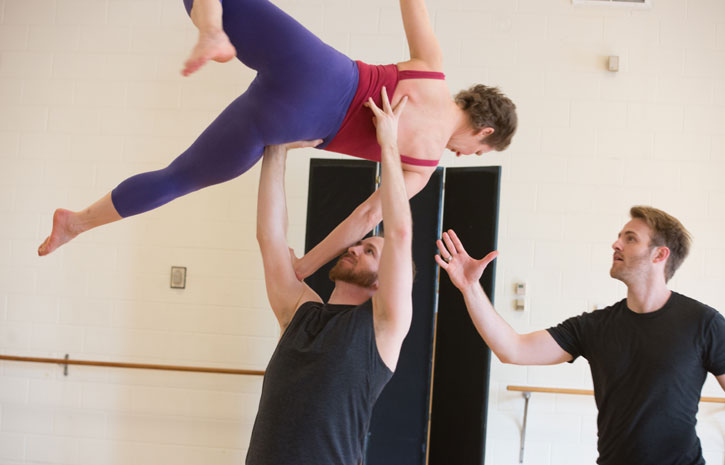Aura CuriAtlas to debut tarot card-themed performance
William & Mary faculty members who created a new dance and music work themed around tarot cards will premiere the piece next week.
“The Fool and the World” will feature Aura CuriAtlas Physical Theatre’s core company performing choreography to original piano music. Performances will be March 9 at 7 p.m. and March 10 at 2 p.m. at the Kimball Theatre.
Joan Gavaler ’85, William & Mary professor of dance and co-artistic director of Aura CuriAtlas, has co-choreographed and will perform the piece with fellow AC principal performers W&M theatre alumnus Dan Plehal ’09, a W&M theatre alumnus and co-artistic director, and founding company member Mickey Lonsdale. W&M Music Professor Sophia Serghi composed and will perform the music, which will be recorded for the premiere.
Serghi and W&M English Professor Nancy Schoenberger have been collaborating on accompanied poetry along these lines for years and artwork was created to go along with it. In 2011, Gavaler did one-person choreography to put movement with a segment featuring nine of the cards.
“You can think of these as branches on a tree,” Gavaler said of ongoing tarot card-themed projects.
Most recently, Serghi suggested a larger collaboration with the dancers featuring the 22 cards of the major arcana deck. Ruminating over the cards and improvising bits at a time, she had worked on the music over the past seven years as it slowly evolved and was shaped by her life’s events.
“Each card has this beautiful symbolism that is completely relevant to stages of our lives,” Serghi said.
Aura CuriAtlas applied for and received grants from the York County Arts Commission and the Williamsburg Area Arts Commission, as well as — through the W&M Department of Theatre, Speech and Dance — from the Virginia Commission for the Arts.
“What we’re reimagining with all 22 cards is how to use dance, theatrical and acrobatic vocabulary to capture some aspects of the 22 cards,” Gavaler said. “In the long term, this is going to be a very flexible show. We’ve got the deck, starting with the Fool and then going through all 22 cards to the World. So you see that spread.
“And then out of that, we would shuffle an actual physical deck and draw three cards to do a layout, a reading, which is how these cards are used. And so you draw these cards, whether you call them random or synchronicity is at work, and the order that you get creates its own energy and associations and maybe a shift of perspective. We’re going to do both aspects, the idea of the deck and the idea of a layout that is a reading.”
Serghi said she and the dancers worked together to fine-tune the fit of the music and choreography, which is different for each project and even each performance.
“The symbolism of the card was the most important,” Serghi said. “Thankfully Joan and Aura CuriAtlas also focused quite a bit on the symbolism.”
The premiere performances will feature the deck of 22 cards in their traditional order. Variations on the cards will be projected on a screen, so that audience members who are possibly unfamiliar with a tarot deck can see what the cards typically look like.
The performers will be doing their own interpretation of a kind of shared tarot reading and inviting audience members to imagine theirs, Gavaler said.
“Some people believe it’s true fortune telling,” Gavaler said. “Some people believe that it’s just fun and great excitement to have these big ideas applied to their own lives. Some people think of tarot as a way to kind of align their conscious and their unconscious mind. I’m more of that type.
“Jungian psychology connects really well with tarot and the idea that the associations you make when you look at, in our case, a very small spread of three cards, the associations that just come into your mind are indeed the issues most pertinent to you in that moment. And so it brings it forward to really engage with, rather than being something that’s running in the background and out of awareness.”
Audience members will be invited to discuss their ideas with the company after the performance. Recordings of Serghi’s piano solos will be played at the premiere, with hope that later shows will feature her playing live.
“Premieres are incredibly exciting, partly because they’re fresh,” Gavaler said. “They’re also raw — in a good way. But they haven’t settled into a highly predictable state. They haven’t been performed enough times to be seasoned and you know what that material is.
“So a premiere is also the first of many, in terms of how a piece then develops further. So I’m hoping over time that we do get to continue to perform it so that it will go through that seasoning process, and become a piece in our repertory that can be used in different ways.”
 Skip to main content
Skip to main content

